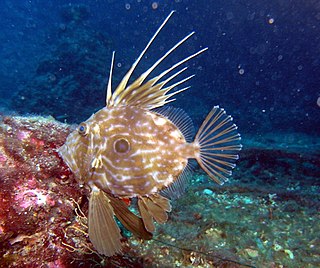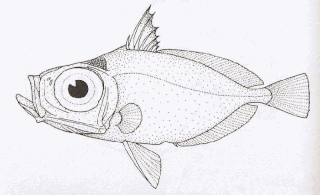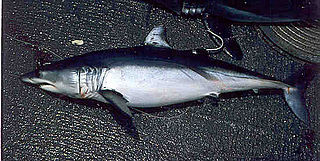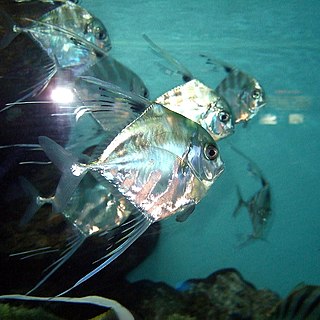
Arowanas are freshwater bony fish of the subfamily Osteoglossinae, also known as bony tongues. In this family of fish, the head is bony and the elongated body is covered by large, heavy scales, with a mosaic pattern of canals. The dorsal and anal fins have soft rays and are long based, while the pectoral and ventral fins are small. The name "bonytongues" is derived from a toothed bone on the floor of the mouth, the "tongue", equipped with teeth that bite against teeth on the roof of the mouth. The arowana is a facultative air breather and can obtain oxygen from air by sucking it into its swim bladder, which is lined with capillaries like lung tissue.

The Zeiformes are a small order of exclusively marine ray-finned fishes most notable for the dories, a group of common food fish. The order consists of about 33 species in six extant families, mostly deep-sea types.

The Moorish idol is a species of marine ray-finned fish belonging to the family Zanclidae. It is the only member of the monospecific genus Zanclus and the only extant species within the Zanclidae. This species is found on reefs in the Indo-Pacific region.

The common name dory is shared by members of several different families of large-eyed, silvery, deep-bodied, laterally compressed, and roughly discoid marine fish. As well as resembling each other, dories are also similar in habit: most are deep-sea and demersal. Additionally, many species support commercial fisheries as food fish. Most dory families belong to the order Zeiformes, suborder Zeioidei:

The Zeidae are a family of large, showy, deep-bodied zeiform marine fish—the "true dories". Found in the Atlantic, Indian, and Pacific Oceans, the family contains just six species in two genera. All species are important and highly regarded food fish supporting commercial fisheries, and some—such as the John Dory —are enjoyed in large public aquaria. These fish are caught primarily by deep-sea trawling.

John Dory, St Pierre or Peter's fish, refers to fish of the genus Zeus, especially Zeus faber, of widespread distribution. It is an edible demersal coastal marine fish with a laterally compressed olive-yellow body which has a large dark spot, and long spines on the dorsal fin. Its large eyes at the front of the head provide it with binocular vision and depth perception, which are important for predators. The John Dory's eye spot on the side of its body also confuses prey, which are scooped up in its big mouth.

Paracanthurus hepatus is a species of Indo-Pacific surgeonfish. A popular fish in marine aquaria, it is the only member of the genus Paracanthurus. A number of common names are attributed to the species, including regal tang, palette surgeonfish, blue tang, royal blue tang, hippo tang, blue hippo tang, flagtail surgeonfish, Pacific regal blue tang, and blue surgeonfish.

Enoplosus armatus, commonly referred to as the old wife, is a species of perciform fish endemic to the temperate coastal waters of Australia. It is the only modern species in the family Enoplosidae.

The elongate dory is a dory in the genus Zenion found around South Africa, Mozambique, Kenya and New Zealand at depths of between 330 to 700 metres. It grows to a total length of 16 centimetres (6.3 in).

Cyttus is the sole genus in the family Cyttidae a family of large, showy, deep-bodied zeiform marine fish. Members of this genus are found in the Atlantic, Indian, and Pacific Ocean.

Isurus is a genus of mackerel sharks in the family Lamnidae, commonly known as the mako sharks. They are largely pelagic, fast predatory fish capable of swimming at speeds up to 50 km/h (31 mph).

Pangasius is a genus of medium-large to very large shark catfishes native to fresh water in South and Southeast Asia. The term "pangasius" is sometimes used to specifically refer to the commercially important basa fish, P. bocourti.

Alectis is a genus of fish in the family Carangidae containing three extant species, all of which are large marine fishes. They are commonly known as threadfish, diamond trevallies or pompanos, although they have no close affiliation with the true pompano genus.

Zeus is a genus of dories.

Zenopsis is a genus of dories, a group of marine fish. There are four extant species, but the genus is also known from fossils dating back to the Oligocene epoch. They largely resemble the better-known John Dory, and are typically found in relatively deep water, below normal scuba diving depth.
Cladocyclus is an extinct genus of Ichthyodectidae. It was a predatory fish of about 1.20 metres (3.9 ft) in length, found in the Albian Romualdo and Crato Formations of the Araripe Basin in northeastern Brazil. The species Cladocyclus geddesi is known from the Winton Formation of Australia. Cladocyclus pankowskii, discovered in the Cenomanian Kem Kem Bed of Morocco in 2007, is reclassified to genus Aidachar.

Tarasiiformes is an extinct order of prehistoric ray-finned fish.

Doryichthys, river pipefish, is a genus of Asian freshwater pipefishes.

Cyttopsis is a genus of fishes.

Potanichthys is a fossil genus of thoracopterid fish found in deposits from China dating to the Ladinian age of the Middle Triassic epoch. It contains only one species, Potanichthys xingyiensis. It is known to have been the first vertebrate ever to have glided over water, and thus the first fish ever that had over-water gliding strategy. The genus name Potanichthys is a portmanteau of the Ancient Greek ποτάνος and ιχθύς. The species epithet refers to Xingyi city which is near the site where Potanichthys was discovered.

















